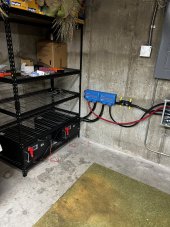@Benzimidazolone
With 12.8kW of solar going through your MPPT in the SolArk and 25kWh of batteries you have a lot of flexibility to AC couple to the SolArk,
As far as I can tell you can AC couple more kWs if you use the Gen port. (I will try to find the specifice) I think the reason is that the gen port allows SolArk to open the port to shut down the AC coupled inverters in the situation when the grid drops and there is very little load. If you use subpanel connected to the load side of the SolArk, it has to use frequency Watts to control the AC coupled inverters and there is some latency so the SolArk algorithm needs some time to ramp down the GT inverters. This is pure speculation on my part based on previous experience with an Outback Skybox, much reading about AC coupling and my fairly recent experience with my new SolArk.
The pros and cons about using the Gen port or going through a subpanel are based on user preferences. I chose to go through the Gen port because I never intend to need a generator. One of the benefits may be that you get the internal shunts to measure your GT inverter(s) generation on your SolArk reporting. Other factors include how much capacity you want to couple and whether you want to use the Gen port for some other purpose. Remember this is only a factor when the grid is down and you want the SolArk to be the Grid Forming source to AC couple to GT inverter(s). When the grid is up the grid is a buffer and the SolArk can pass through as much as either of those ports will allow. As mentioned above, if you do use a subpanel, there is a NEC backfeed rule that must be followed. Hope that helps frame the issues for you. I love my SolArk.




